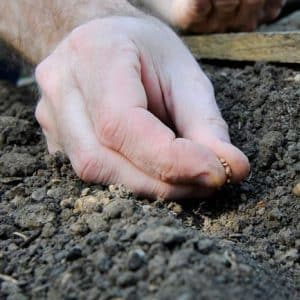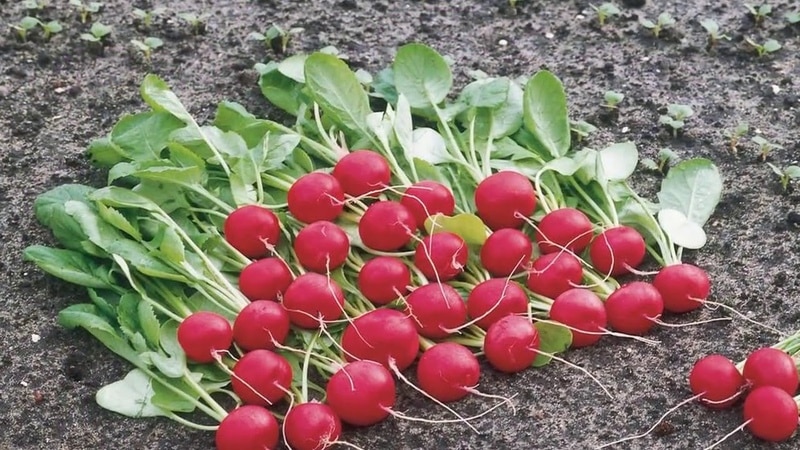When is it better to plant radishes before winter and is it possible to grow a good harvest?
Radishes are the first vegetable that appears on our tables in the spring. Thanks to its beneficial composition and rapid ripening, the crop has gained universal popularity and grows in almost every garden.
How to grow the earliest radishes? Is it possible to plant radishes before winter and when to do it? What are the growing conditions for winter radishes? You will receive detailed answers to all these questions in the article.
Is it possible to plant radishes before winter?
The only drawback to planting radishes before winter is the risk of seed death if the grower chooses the wrong time for sowing. However, this rarely happens, so let’s pay attention to the advantages of the method:

- Unlike spring sowing, winter sowing brings the harvest several weeks earlier. If you cover the crops with polyethylene in the spring, the ripening time will be reduced by a few more days.
- Seeds sown in autumn are much stronger and stronger than spring seedlings, as they are hardened in the ground and become resistant to many aggressive factors. Weak seeds die, and strong ones develop faster.
- Pre-winter sowing provides the seeds with the necessary moisture after the snow melts. Seeds also undergo a process of natural stratification. Spring crops may suffer from a lack of moisture due to the soil being overdried by the active sun.
- When sown in winter, radishes become resistant to diseases and pests and are not afraid of frost.
Having tried growing radishes in this way once, the vegetable grower will return to this method again, since this method has a lot of advantages.
When to plant winter radishes
Planting time depends on the weather: seeds are sown with the onset of stable cold weather. Warming after planting can destroy all crops, as the seeds will germinate and freeze from returning frosts.
Planting is carried out in stable weather with a temperature of 0...-1°C, when the top layer of soil freezes.
What varieties of radish are best to plant before winter?

The ideal radish variety for winter sowing has the following characteristics:
- not afraid of lack of light;
- frost-resistant;
- not prone to shooting.
Experienced gardeners prefer varieties such as Zhara, Zarya, and Rose-red.
Heat and Dawn ripen early. Root crops are harvested 15-25 days after germination. In addition, Zarya is distinguished by its high yield and resistance to light deficiency. The fruits have a pleasant taste, slightly spicy.
Rose-red radishes ripen at an average speed: vegetables begin to be harvested in approximately 25-30 days after emergence. This variety It has a balanced taste, which is why it is very popular.
Planting radishes in the fall, before winter, is a risky business, but if you follow all the rules, then in early spring you can delight yourself with fresh vegetables.
How to properly plant radishes before winter
Before the onset of frost, the bed reserved for sowing is slightly loosened and fluffed up. The site is chosen on a slight elevation so that when the snow melts, the seeds do not flood.
Soil preparation

Autumn radishes grow well in garden beds where cucumbers, tomatoes, garlic, potatoes, peas and beans were previously cultivated.Undesirable predecessors: Cabbage, daikon, radish, horseradish and watercress are all members of cruciferous vegetables, as they accumulate common diseases and enemies that are transmitted through the soil.
The soil is prepared immediately after harvesting the previous crop. The soil is dug up, at the same time removing weeds and plant debris. Under digging for 1 sq. m add 25-35 g of superphosphate and ammonium nitrate, and also add 35 g of potassium sulfate - preferably in dissolved form.
On a note. If the soil on the site is severely depleted, then compost or humus is added to it (a bucket per 1 sq. m).
After digging and applying fertilizer, the soil is well loosened to a depth of 18-22 cm, this depends on the chosen litter.
Seed selection and preparation
First, the seeds are calibrated: placed in a saline solution for several minutes. The seeds that float up are thrown away, and those that sank to the bottom are taken out and dried. Next, the seeds are disinfected for about 20-30 minutes in a slightly pink solution of potassium permanganate, washed and dried again. Such preparation will allow you to grow large fruits and protect the crop from diseases. It is important that the seeds only swell, but do not germinate, otherwise they will die.
On a note. For autumn planting, prepare twice as many seeds as for spring sowing, since the planting material may be of poor quality, the seeds will not hatch and will die.
Planting pattern and depth
Grooves are made at a distance of 20 cm from each other. Then dry seeds are embedded in them to a depth of no more than 5-6 cm. Leave 3-5 cm between the seeds. The crops are sprinkled with dry soil.
The bed is covered with a layer of mulch, which will act as a protective cushion for the seeds.Mulching will protect the seedlings from temperature changes, spring thaws and frosts. Spruce branches or branches of shrubs are used as mulch. The bed is covered with a 20 cm layer. In winter, the beds are insulated with snow - this will help the seeds to successfully overwinter.
Important! The place where radishes are sown should never be moistened, otherwise the seeds will hatch and die from frost.
Features of caring for such a planting
When warm weather arrives, the shelter is removed and the first shoots wait for the appearance. First of all, plants are provided with a comfortable “population density”. To do this, remove the weakest shoots so that the distance between the root crops is at least 5 cm.
Watering
Water depending on rainfall. Due to a lack of moisture, fruits become tough and will taste bitter, and due to its excess, vegetables become watery and tasteless. If there is no rain, water, but moderately. To prevent the formation of a crust on the top layer of soil from watering, the soil must be loosened.
For your information. Radishes are grown both in separate beds and in mixed plantings next to cucumbers, potatoes and cabbage.
Top dressing
If the soil is depleted, a herbal infusion diluted with water is used as a fertilizer. To prepare the fertilizer, fill the container a quarter full with water, then add recently collected herbs at the rate of 1 kg of plants per 10 liters of water and add 2 kg of dry chicken manure. The container is covered with a net.
The infusion is stirred every day and used only after the mixture stops fermenting, that is, when bubbles stop appearing. This takes 1-3 weeks. The resulting infusion is mixed with water in a 1:1 ratio. The product is watered at the roots of the plants.
On a note. If the soil is fertile, it is not necessary to apply fertilizers.
Diseases and pests
With the onset of warm weather, winter radishes are at risk from whiteweed, cruciferous flea beetles, clubroot, bacteriosis and blackleg.
An effective and safe way to control insects is to use ash and tobacco dust. If there are few pests, it is enough to lightly dust the tops with ash. Ash particles enter the respiratory tract of pests, causing their death.
In the future, to protect the plants, the radishes are sprinkled with lime and ash in a 1:1 ratio once a week. The procedure is carried out in dry weather and must be repeated after rains. A decoction of onion peels, which is used to water the seedlings, also helps well. The pungent odor repels insects.
In case of massive damage to plants, the following drugs are used:
- "Arrivo";
- "Kaiser";
- "Zolon";
- "Alfacin";
- "Tod."
Bordeaux mixture or lime solution is used against bacteriosis and clubroot: 100 g of lime is stirred in 2 liters of water. Blackleg is treated with a solution of 50 g of laundry soap and 1 tbsp. l. copper sulfate diluted in 10 liters of water.
Harvesting and recommendations

Before harvesting vegetables, the garden bed must be watered. Before morning harvesting, the soil is moistened in the evening, before daytime harvesting - 2-3 hours.
Recommendations for proper collection and storage of root vegetables:
- When harvesting, radishes are simply pulled by the tops.
- Before pulling the radish out of the ground, the soil from the top of the plant is lightly raked to determine the size of the root crop. All vegetables with a diameter of 2.5 cm or more are removed. If the root crop of the selected plant is still small, it is sprinkled with earth, allowing it to ripen.
- Since winter radishes ripen quickly, vegetables are checked as often as possible so as not to miss the right moment of collection.
- For further storage, vegetables are shaken off the ground, but not washed, and the tops are cut off, leaving 3 cm.The fruits are placed in a plastic bag and sent to the refrigerator. This way, root crops will retain their marketability and taste for a long time.
Read also:
Features of planting radishes in July.
Why radishes go into color and how to grow them correctly.
We choose the best fertilizer for radishes and apply the fertilizer correctly.
Conclusion
It is enough to master the agricultural technology of growing winter radishes once, and you will never give up this method. Choose a site on a hill, do not plant after fellow cruciferous plants, do not water the seeds in the fall - and harvest a fresh harvest in early spring.